"Mom, I'm back ..."
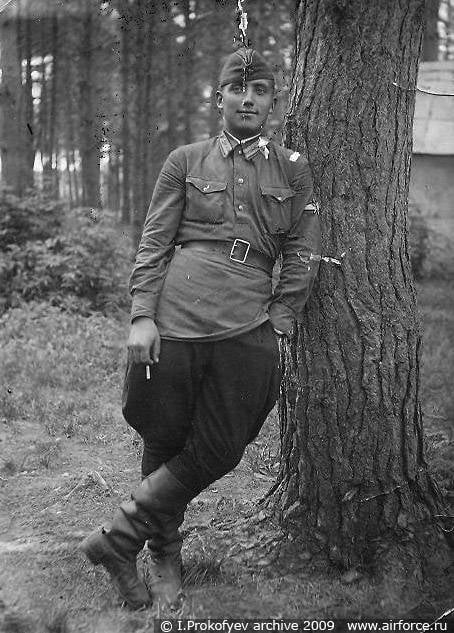
The reason for writing this stories served the detection of the site of the crash of the Il-2 aircraft and the death of two crews of the 872 th assault air regiment of the 281 th assault air division of the 14 th Air Army of the Volkhov Front ...
In mid-August 2007, one of the local hunters led the fighters of the search unit "Jaguar" from the village of Nurma of the Tosnensky District under the leadership of Pyotr Moseychuk to the Yereminskoye bog area, which is located on the border of two districts of the Leningrad Region - Tosnensky and Kirovsky. The places are deaf, there are few berries and mushrooms in these swamps, the locals bypass these places, and the hunters, catching game, mostly move along the ditches, which were dug up in 50 – 60 years for amelioration. Therefore, the place of the crash of the aircraft and its fragments on the surface of the swamp for a long time remained unnoticed by anyone.
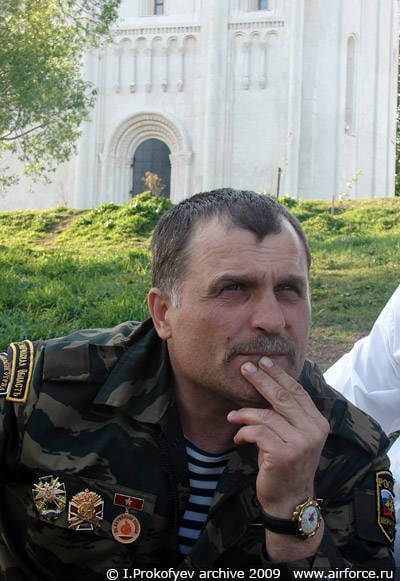
Moseychuk Petr Petrovich
Upon arrival, the search engines determined that in front of them were fragments of the Soviet Il-2 attack aircraft. The tails and wings of the aircraft were scattered on the surface of the swamp. A part of the left plane protruded from a funnel completely covered with moss.
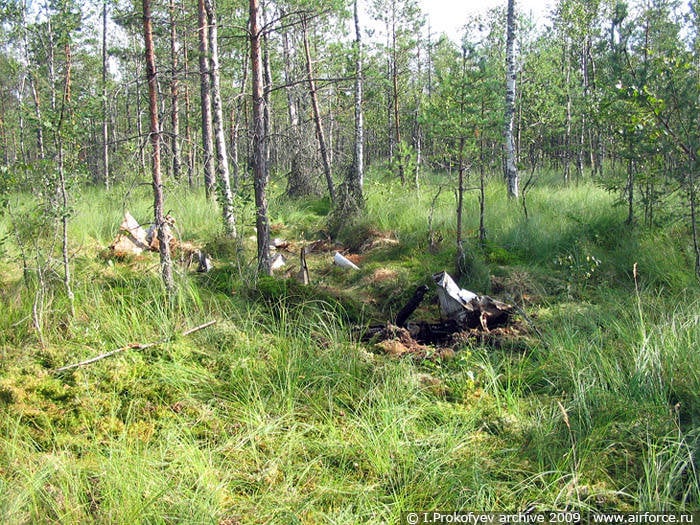
Place the fall of IL-2
From all that he saw, it was concluded that the place of the fall was not subjected to any intervention, in other words, to plunder of non-ferrous metal. Search engines are constantly faced with the fact that in the postwar years, many local residents mined an additional income, collecting scrap metal fragments. But in this place a picture of the tragedy of sixty years ago appeared before their eyes. The wreckage of the aircraft was precisely in those places where they were thrown back by the force of the explosion when the plane fell. It seemed that this place, indeed, had not been walked on for more than sixty years.
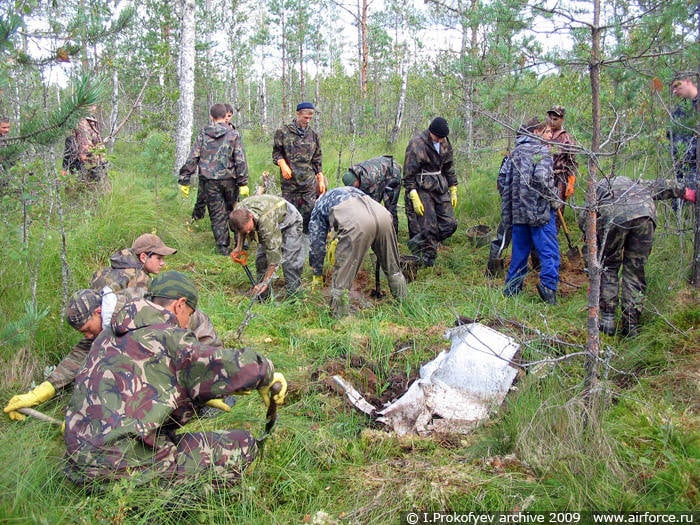
Beginning of work
At the first survey of the crash site and the wreckage of the aircraft, it was not even possible to establish the date of its death, as it was not possible to find any substantial circumstantial evidence. (Indirect evidence that helps direct researchers to the correct path to the goal of determining the fate of the deceased aircraft and its crew is the various units and structures of the aircraft, its on-board armaments, which were marked with the date of their manufacture. So, if you can find cartridges or shells for aircraft armament with the release date of 1943, it becomes clear that this aircraft could not die in 1941 or 1942, thereby reducing the time frame in which the found aircraft could die. Knowing the location of the fall from Ameleta, its geographical location, we can bind this place to the settlements located in the district, thereby checking exactly the aircraft that are listed in the combat reports of the dead in the area of these settlements.) Unfortunately, the first survey of the fall of such indirect data gave few. We became aware of the type of aircraft - the Il-2 attack aircraft, and the place of its death is the Yereminskoye bog, located in the triangle of the Cap-Maluksa settlements - the Belovo tract. However, due to the fact that in the area of these settlements were listed dead in the period from. 1941 on 1944 year a large number of aircraft IL-2, we even could not say which part could belong to the aircraft.
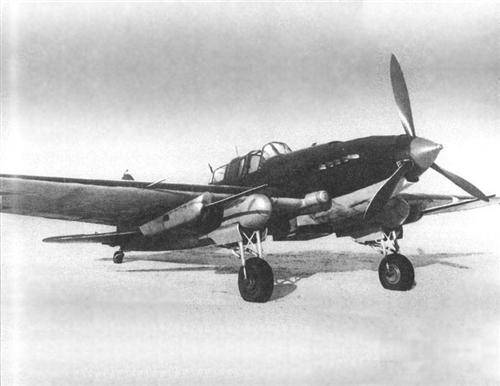
IL-2 1943 of the year (ZM type) - double
Every year, search engines from Novosibirsk, the “Courage, Heroism and Volia” detachment, come to us in the Leningrad Region, students of the Siberian Cadet Corps, led by Natalia Izotovna Nekrasova. For more than 10 years, Novosibirsk, together with the search engines of the Leningrad Region, have participated in expeditions to search for and lift wrecks of Soviet aircraft. This time we invited our friends, telling Natalia Izotovna and her children about the discovery of the Nurmenian search engines on the Eremensky bog. Siberians agreed to help us. And here 28 August 2007, the combined expedition as part of the Novosibirsk "MGIV" and St. Petersburg "Rubin" went to the place of the crash. Coming to the place where the plane crashed, and quickly deploying a small camp and bivouac, the guys set to work. First, moss was removed, which overgrown the entire surface of a large funnel in the swamp. It took several hours of laborious work. Constantly among the moss and roots came across various small fragments of the aircraft, its tail. After cleaning the funnel from the moss began to pump out the water. A small portable pump worked, but the pop-up peat had to be constantly picked up with buckets. To do this, the majority of search engines were divided into two groups and began to transmit buckets filled with water and peat along a chain. The depth of the swamp was no more than one and a half meters, therefore, having reached the bottom of the swamp, the guys took up shovels. After some time, the clay mixed with sand and water began to turn into sandy loam, and a silt formed in the funnel.
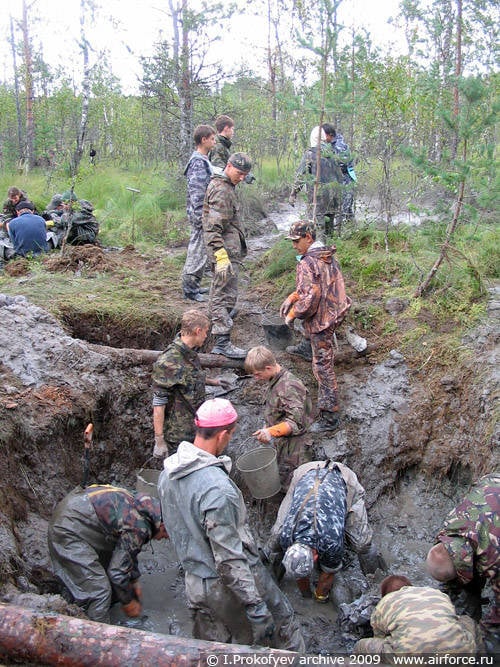
Work at the crash site
It was not possible to achieve complete lack of water in the funnel: water constantly came from the swamp, there was a tedious drizzle. But despite these difficulties, a lot was done on the first day of work. The whole area of the funnel was completely cleared of moss and roots, it was possible to go more than two meters in one of the parts of the funnel. And, most importantly, during the analysis of the clay from the funnel, two fragments of a human skull were found, which indicated that the crew of the aircraft was killed along with the aircraft.
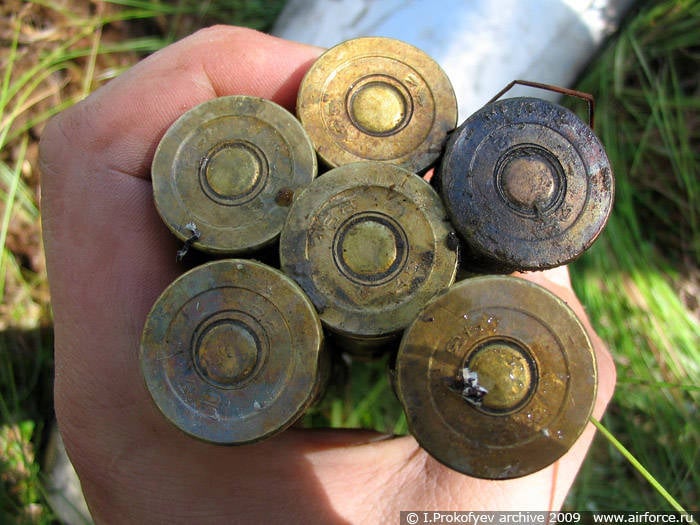
ShVAK cannon cartridges
In the midst of the wreckage aviation ShVAK guns of 20 mm caliber, dated 1942, and this made it possible to narrow the time frame for determining the date of the death of the aircraft. It became clear that this aircraft would no longer be listed in the losses of 1941. On the first day, another interesting find was made. While washing the debris of the airplane’s armored plates from clay and peat, on one of them we found number 39 painted with white paint. In this way, at the factory where the aircraft were made, the workers numbered the removable parts of the engine armor and the airplane’s cabin, the same method was transmitted to the technicians in the shelves when they were doing repairs. Basically, the factory and assembly numbers of aircraft were applied in this way. So, having found on the wreckage of the armor of the Il-2 airplane its serial number duplicated, we could establish the fate of the crew of the dead aircraft. But the figures found also caused a little bewilderment, since in our practice of searching for and recovering the wreckage of IL-2 aircraft, mostly four-digit numbers were plotted, not two-digit ones. But still it could be assumed that these two numbers 39 were the last in the numbering of the serial number of the aircraft, and therefore we began to carefully study the lists of dead aircraft in this area, which at the end of their numbers could have the numbers 39.
Studying the information collected on the basis of archival data on the lost Il-2 aircraft, we found two aircraft that had the numbers 39 at the end of their serial number:
- IL-2 number 1879439 from 57-th Attack Aviation Regiment Air Force CBF, the crew consisting of pilot Sergeant Valery Yaroshevsky and gunner junior sergeant Vasily Mikhailov, who 17 February 1943 years after the attacks of artillery batteries of the enemy in the area north of Nikolskoye village was out of sight. The remaining crews did not observe the disappearance of the aircraft. The accident investigation report in the Red Banner Baltic Fleet air force units on the fate of this crew recorded the following: “allegedly shot down by the enemy’s anti-aircraft artillery in the target area”;
- IL-2 number 1874839 from 7-th Guards Attack Aviation Regiment Air Force CBF (former 57 Assault Regiment Air Force CBF), in the crew: Sgt Guard flight commander Yuri Botvinnikova and gunner Guard Sergeant Eugene Nyquist, who 8 April 1943 years during causing a bomb assault on the Fornosovo road — the Stekolny junction was hit by the enemy’s anti-aircraft artillery during a dive, and fell in the territory of the enemy south of Krasny Bor.
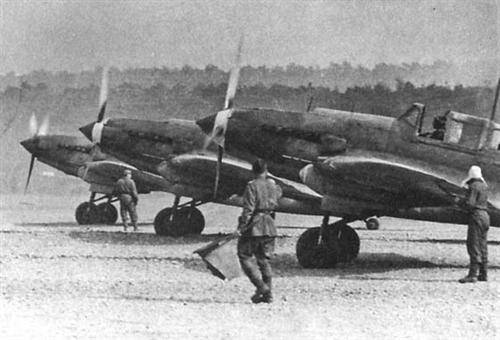
The crews of attack aircraft IL-2 are preparing for departure
But the above crews were listed as dead at a rather large distance from the location of the wreckage of the aircraft, although they were listed as dead in the Tosno district of the Leningrad region. It was possible to assume that the first crew of Yaroshevsky-Mikhailov, shot down or attacked by enemy fighters, managed to reach the Caps-Maluks area and fall in the area. However, the belonging of the found aircraft to these crews was doubtful.
Again, the number we discovered could have been assembly, more precisely, the assembly number of the aircraft at the factory, and therefore could not be found in the archival documents.
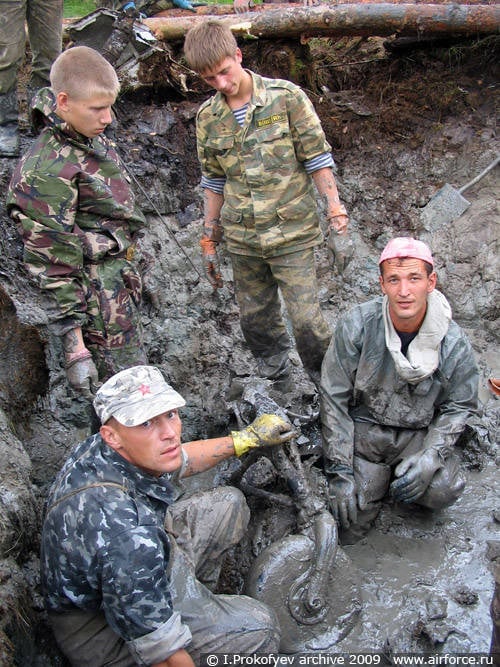
Funnel Works
The second day of work, despite the fact that basically I had to go all the way through the diameter of the funnel and pump out the incoming water for hours, and gave buckets of sand and clay to scoop out buckets, gave additional information. The first find on this day was the finding of highly deformed and broken parts of a large-caliber UBT machine gun of caliber 12,7 mm. This finding made it possible to accurately determine that the wreckage of the detected aircraft belonged to a modification of the IL-2 two-seater attack aircraft.
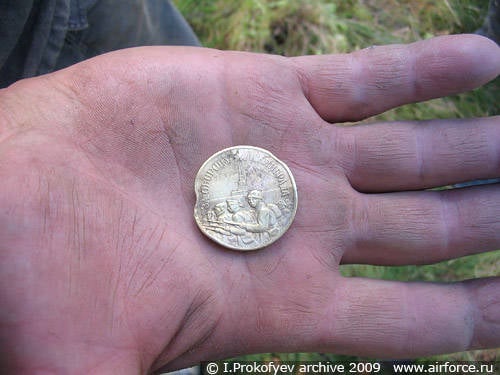
In addition, expanding the diameter of the crater, the guys found a medal “For the Defense of Leningrad” cut off from the bar and heavily dented. This medal was approved only in December 1942 of the year, and the troops began to appear no earlier than May 1943 of the year. This means that the crews of naval aviation had nothing to do with the aircraft that we found.
Clearing the edges of the funnel, we found the remains of two high furrows of one of the aircraft crew members, and in them fragments of legs cut off from the terrible explosion. Throughout the whole working day, in one of the edges of the funnel, there were constantly overwhelmingly broken human bones of the pelvis, legs and arms. Scraps of a flying helmet with one earphone were removed from under the moss, and there were fragments of a skull in it ... Among the twisted aluminum, there were dangling slings and rags of parachute silk. This meant that when the plane crashed, it exploded. The fragments found in the wreckage and detonators from 100 kilogram air bombs suggested that the bombs aboard the aircraft detonated during the fall.
The third day was decisive. In the morning on the railway platform in Malux we met the search engines from Novosibirsk who came to the rescue.
… Monotonous rumbles included motor pump. Habitual chains of people in camouflage transfer buckets filled with peat slurry from hand to hand. At the fire, women are expeditiously disposed of by the physicians of the expedition, who are also part-time cooks. We carefully wipe the wreckage of the aircraft armor removed from the funnel with moss. Careful not to erase the paint, which was covered with steel in the distant military year. And good luck, on one of the armor plates the number painted with yellow paint is clearly visible: 18 / 22.
That's exactly the number of the aircraft! Now, after returning from the expedition, we are guaranteed to install the crew of the aircraft, even if there are no documents with the dead. Unfortunately, in the printout for the dead IL-2, made by us for work in the forest, there was no such number.
Towards the middle of the day at a depth of more than three meters we reach the cockpit of the air gunner. The wooden frame of the aircraft fuselage made of puff plywood and delta-wood, like a cocoon, pinched the body of an air shooter. The lower armor plates pressed the victim to the central gas tank protection plate. Digging around the perimeter, we find two rocket launchers and a parachute exhaust dome. With our hands, through a small layer of sandy loam, we probe the body of an unknown member of the aircraft’s crew. We dig indentations in one of the edges of the funnel and lower the constantly flowing water there. The body of the air gunner is in front of us. We are trying to lift it with our hands, but we are not able to do it: a uniform soaked with water and a parachute add extra kilos. We skip the rope attached to the winch through the parachute straps, lift the body from the broken cabin. Then we take a cape and plant it under the remains of the deceased. The six of us hardly pass the heavy cape up to the hands of the receiving guys ...
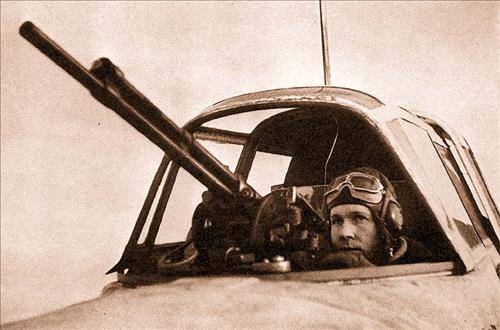
Air gunner defender attack aircraft Il-2
Comprehending what is happening, we begin to understand that in the first days of the expedition we found the remains of the pilot of the aircraft. It turned out that the pilot’s body suffered the most during the explosion, and the air gunner, most likely killed or wounded while still in the air, was at the bottom of the cockpit when the plane fell, so his body did not suffer much from the explosion.
And here is the body of the aircraft air gunner on the surface. Carefully release it from the parachute straps, undoing the carbines. He is dressed in a light-brown technical jumpsuit, with wet boots on his feet. A cloth tunic with a stand on the collar (sample 1943 of the year) is visible from under the jumpsuit. Unzip the buttons. On the shoulders of a private soldier with a large button with an asterisk, which gleams brightly, reflecting the rays of the sun. The main thing is documents! After all, if they turn out to be at the shooter, then today we will know his name and we can say what kind of crew died here.
Carefully remove moor-soaked personal items. The guys are quietly talking behind his back. For many, the discovery that after more than sixty years, the human body can survive. Among Novosibirsk residents there are those who first came to the search expedition, for them everything that happens is a shock. In the patch pocket of the jumpsuit we find the soldier's cap, followed by the rolled-up newspaper. Aviation gasoline played the role of a good preservative, everything is saturated with them and therefore it is possible to open a newspaper right by hand. We read the name - "Leningradskaya Pravda". Day of release - 23 July 1943 of the year. Wow! We are talking loudly: it means that this crew died in the summer of 1943 of the year! And, most likely, in the course of the Sinyavinskaya or Mgininskaya offensive operations. The main losses of our aviation in the course of these operations were in the area of the settlements of Sinyavino, Mga, Voronovo, Porechye, Slavyanka ...
We continue to consider the personal belongings of the deceased air gunner. Here is a small typesetting mouthpiece, two box of matches, a spare red starlet for headgear. Among the papers there are two envelopes, and enclosed letters are visible in them. Who are they from? .. Most likely, from relatives or friends. On one envelope you can see the postmark and the stamp “verified by military censorship”. Two small notebooks turn out to be empty; records are not visible on any sheet. On a small piece of paper, partially torn, pencil notes are visible - these are encodings for communication. We read the words: land, guidance station, Sandil, Kolosar, Kipuya - these are the names of our airfields, we read further: division commander, KP, Tanks...
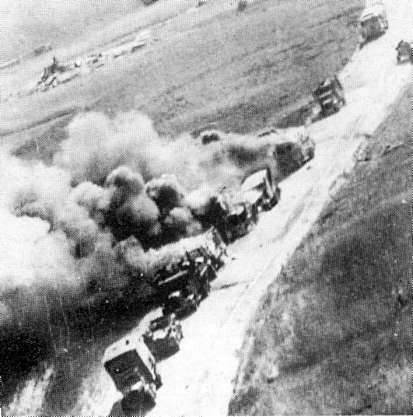
German convoy under attack IL-2
A small hardcover book turns out to be a cadet book, for some reason there is no first page where the owner's data is written. Pages begin with the razgraflennoy parts: date, serial number of the flight, time, flight tasks for the next day, errors noticed by the cadet, cadet errors and instructor's instructions ... Unfortunately, all the pages are empty, none of them even show strokes from the records . Among the pages we find the coupons put in there for breakfast, lunch and dinner, for all the inscription indicating the nutritional rate — flight.
In the purse, in addition to letters, two certificates are attached. Carefully picking up the sharp tip of the knife, uncover soaked paper. The text is not visible, but in the upper left corner the stamp is clearly read: USSR Berdsky College of Agricultural Mechanization of Narcotic Drugs ...
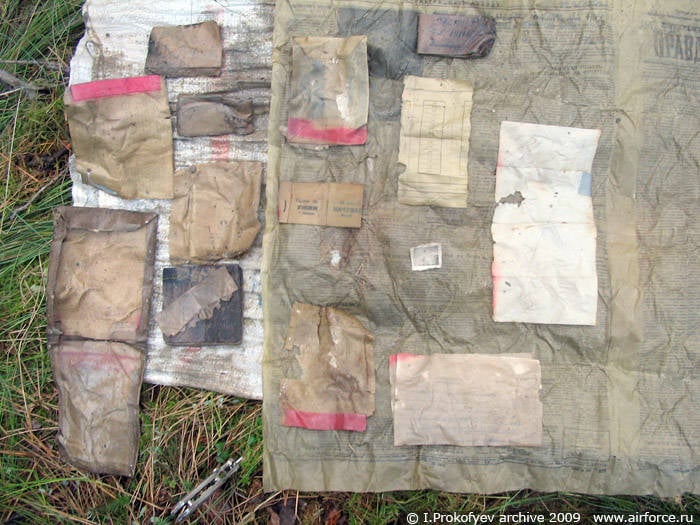
Documents found at the air gunner
Berdsky? This is the city of Berdsk in the Novosibirsk region! The news that the deceased graduated from the Berdsk Technical School in the Novosibirsk Region, spreads with great speed. On the faces of Novosibirsk genuine surprise. Arriving in the Leningrad region from Siberia, a few thousand miles from his home and find the remains of his countryman! In the eyes of the girls from Novosibirsk tears.
Carefully parse the second certificate. This form is typed on a typewriter. The lines to be written are written in special ink, therefore we read the text right on the spot: “... Prescription. To: Red Army man Chuprov K.A. I offer you 13 June 1943 year to go at the disposal of the commander of 281 assault air division for further service. The date of arrival is 14 June 1943. The basis: Order 5 of department of UF and BP of the Air Forces. The commander of the training aviation squadron, Major Rybakov ... ".
Here it is, it happened! We know the name of the deceased air gunner. But the name of the deceased is puzzling! The fact is that private Kuzma Alekseevich Chuprov was an air gunner in the crew of the pilot Guriy Maximov, who, as we know from various memories published after the war, sent his burning plane to the enemy ammunition depot in the Borodulino area. This is a widely known crew for people involved in the history of aviation during World War II! We stand in a daze! How so? Only having returned to the city, having studied archive documents and memoirs, we will be able to reveal this secret! But there is no doubt anymore, we did find the crew of Maximov - Chuprova
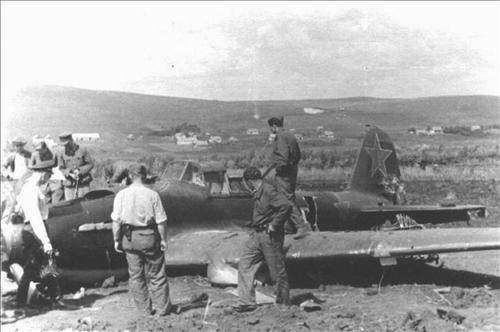
Germans inspect IL-2 shot down near Stalingrad
A week later, on regular weekends, the combined expedition of the Vysht detachments under the leadership of Viktor Dudin, Rubin under the leadership of Nikolai Mikhailov and the Kingisepp Outpost under the leadership of Viktor Kostyukovich, fragments of the engine and gearbox of the downed aircraft were lifted from the bottom of the funnel. The force of the explosion when the plane fell, was so great that the front four pistons, together with the cooling sleeves, were simply pounded into small pieces from both rows of the engine. Since the plane fell with the engine running, the gearbox with the propeller was torn off, and they were in the funnel much higher than the motor, all three propeller blades were torn off and badly bent.
Returning from the forest, we immediately sit down to study the available materials and documents. And this story turns out to be no less exciting than the work that was carried out in the marsh while lifting debris
Now let us turn to the scientific work, which prepared a whole team of employees of the Institute of Military History of the USSR Ministry of Defense. This work is called “On the Volkhov Front. 1941 – 1944 years. ”, Was published by the publishing house“ Science ”in 1982 year. That’s what the military historians said about the exploit of the Maximov-Chuprov crew: “... In the fierce battles with the Nazis, the crew of the IL-2 attack plane, consisting of pilot Sergeant G.N. Maximov and a radio operator private soldier K.A. Chuprova. In the first six days of the operation, they conducted 13 successful sorties. During the second departure of 22 on July 1943, the aircraft dropped bombs on the target, and then fired missiles. But as a result of a direct hit by an anti-aircraft projectile in the left plane, a huge hole was formed in it. Despite serious damage to the aircraft, the crew made another attack and returned independently to the airfield. During 13-th flight departure, the crew participated in the assault of enemy troops and equipment in the Borodulin area. At the exit of the attack from a direct hit by an anti-aircraft projectile, the attack aircraft caught fire. The decision was made instantly. The plane, engulfed in flames, spun around sharply and crashed into ammunition depots. Fighting friends observed a huge explosion, accompanied by smoke and flames ... ".
Referring to the documents stored in the Central Archive of the Ministry of Defense of the Russian Federation. In the book of accounting for the loss of personnel of the 281 th assault air division, we read:
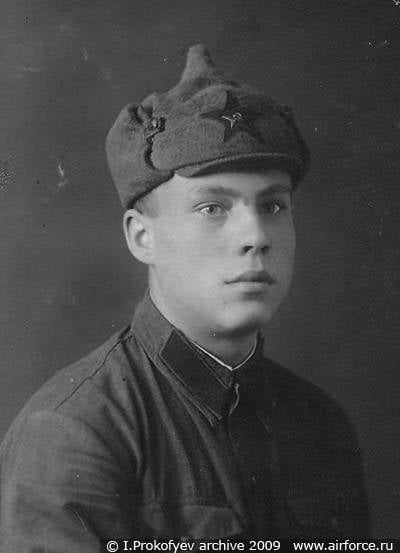
Pilot Maksimov G.N. 1940 year
- Maksimov Guriy Nikolayevich, sergeant, pilot of the 872 SHAP. Born 1919, born: Ivanovo Region Vladimir. Been charged: Propulsion Vladimir RVK. 27 July 1943 of the year was killed during a combat mission. Hit a burning plane in the enemy’s ammunition depot. Family address: Maximova’s sister, Galina Nikolaevna, Ivanovo Oblast, city Vladimir, ul. Railway d. 9;
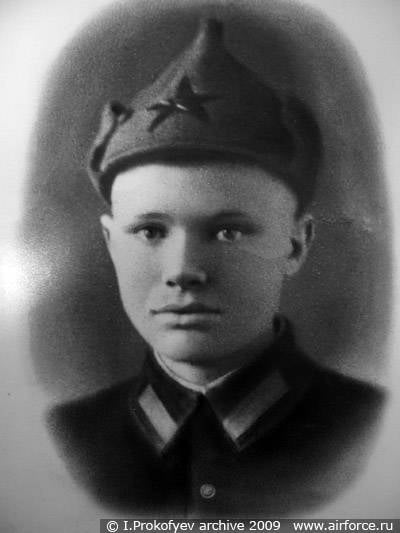
Red Army Chuprov K.A.
- Chuprov Kuzma Alekseevich, Red Army man, air gunner 872 th SHAP. Born 1925, born: Altai Territory Fast-Istok District, village of Verkhnee-Tula. Been called the Fast Istok RVK. 27 July 1943 of the year was killed during a combat mission with pilot Maksimov. Family address: Anastasia Yakovlevna Chuprova’s mother. Novosibirsk region Novosibirsk region village Verkhnee-Tula.
In the loss lists of the 281 th assault division for 27 July 1943, one more crew of the 872 th assault aviation regiment, which consisted of pilot Lieutenant Ivan Panteleevich Lyapin and air gunner Sergeant Mikhail Mikhailovich Kuzmin, was killed. Opposite their surnames, the same wording is written: they did not return from a combat mission. Why are we talking about the second crew killed on the same day, when the crew of Maksimov-Chuprov died: both crews are not returning 27 July 1943.
The next document of the Central Archive of the Ministry of Defense, which we studied, was the logbook of the engineer of the 281-th ShAD, in which all the losses of the division’s materiel, breakdowns, forced landings and other incidents were recorded daily:
“... 27 July 1943 of the year.
- Il-2 aircraft. Crew pilot Junior Lieutenant Maximov, air gunner Sergeant Chuprov.
- Il-2 aircraft. Crew pilot Lt. Lyapin, air gunner Sergeant Kuzmin.
- Task to be carried out: Free hunting for the reconnaissance and destruction of enemy personnel and equipment on the following sections: Caps - Lyuban, Mga - Caps, Tosno - Lyuban, Lesye - Nurma.
- Location: not known.
- Circumstances of the incident and the reason: they did not return from the combat mission.
- The state of the aircraft and crew: not known.
- Note: did not return from a combat mission ... ".
From the above, we can conclude that the crews of Maximov-Chuprov and Lyapin-Kuzmin performed the same combat mission - free hunting on the roads where the German units were moving. Both crews did not return from a combat mission. Some time later, it becomes known that the crew of Maximov-Chuprov sent his plane, shot down by anti-aircraft fire, to an enemy ammunition depot, and these documents do not indicate the place where the ram was made and the source of information was not indicated, how did it become known about the ram?
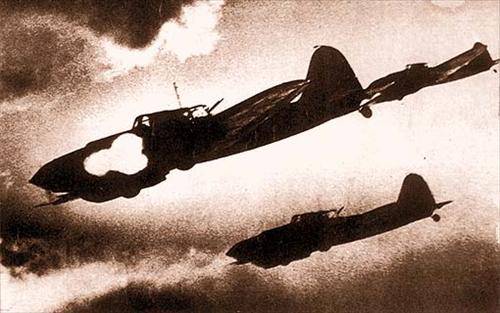
IL-2 in attack
Taran was! This is confirmed by Leonid Aleksandrovich Semenov, a resident of the city of Lyuban, and his brother, who lived as boys during the war years with their parents in the village of Borodulino. Here, probably, it is necessary to explain to the reader about the village Borodulino itself. The fact is that even in the pre-war years, on the fields near the village of Borodulino, which still exists and is located just on the Lyuban-Kapki road in 2 km north of the city of Lyuban in the Tosnensky district of the Leningrad region, there was a small airfield. With the capture of this territory by the Germans in August 1941, this airfield was reequipped, and became one of the numerous centers of the cluster of enemy aircraft near Leningrad and belonged to the so-called “Siverskoy aeroduz”. It is clear that the airfield itself and its surroundings were well equipped with anti-aircraft batteries. At the airport, both enemy fighter aircraft and bomber aircraft were based. Borodulin airfield until January 1944 was marked on the maps of the Soviet General Staff as the first target for destruction. How many crews of Soviet aircraft were killed during the bombing of the airfield? This is known, probably, only by God.
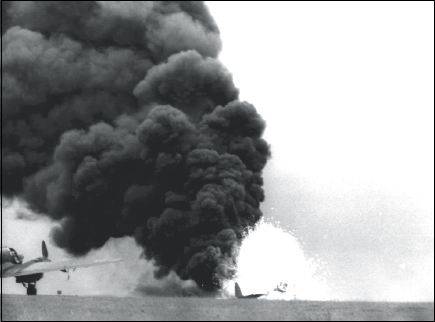
The explosion of "Heinkel", struck during the attack of IL-2
So, in the summer of 2006, we communicated with Leonid Aleksandrovich and his brother. The fact is that Leonid Aleksandrovich himself, having heard about the work of the search party to search for downed Soviet aircraft, found the search engines and said that in the Borodulino area he had seen wreckage of the aircraft. It was in 1945, when he and his family returned from forced German evacuation to Estonia. We wandered together for a long time in a swampy forest near the village, and only later it turned out that the plane that Leonid Aleksandrovich had seen in its debris in 1945 was German and had been dug by excavator during land reclamation work in this area. When we returned to the village, and Leonid Aleksandrovich told a lot of interesting things about life in Borodulino during the war under occupation, I asked: “Did you hear anything about the land ram committed in the summer of 1943 of the year ...?”. Leonid Aleksandrovich's answer struck me: “Yes, what are you? So "shandarahnulo" that the Germans walked around for two days. All the women in the village washed their pants ...! ”. Leonid Alexandrovich showed us the place where the Germans had hangars and caponiers. It is clear that the locals were not allowed to go to the airfield, they mostly drove to level the airfield after our bombardment. But the boys are the boys, they were all interested, and the airfield with its own airfield adjoined the village. Unfortunately, the grandfather could not tell us the details of the accomplishment of this feat, since the entire local population during the bombing always hid in the basements, where they were evicted by the Germans or dug in the dugouts, in their gardens. The fact is that, according to Leonid Aleksandrovich, the village got into the bombing, and often our Russian bombs fell on the houses ...
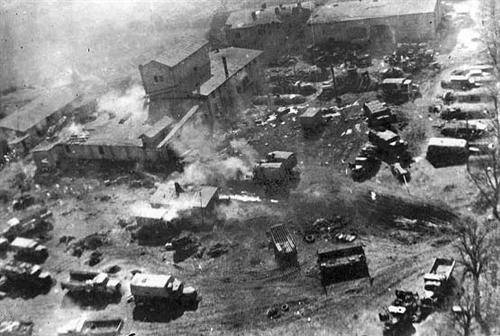
A blow to the accumulation of technology. Photos from the cabin IL-2
Based on the stories of local residents of the village of Borodulino, we knew for sure that the fact of the accomplishment of the heroic deed - the fire ram in Borodulino was! Now, the question posed itself. So who rammed a warehouse of ammunition Germans in Borodulino? After all, we found fragments of the Maximov-Chuprov crew's plane in 24-km north of Borodulino. But this almost does not implore the feat accomplished by the crew of Guriy Maximov and Kuzma Chuprov. No, you did not think! They also accomplished the feat! Only one fact of death in the terrible sky of the war is a feat. Judging by the results, the search expedition to raise the wreckage of their aircraft can safely say that they were shot down while attacking the airfield Borodulino ...
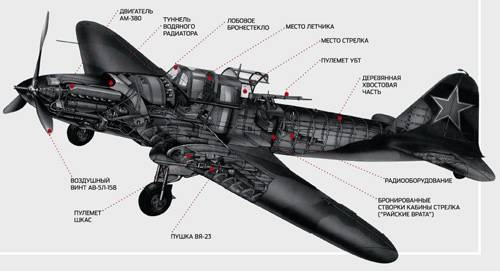
Bomb-rifle armament of their Il-2 aircraft consisted of two 20-mm and ShVAK cannons, two 7,62 mm ShKAS machine guns that stood in the wings of the aircraft, six rocket projectiles of the 82 mm caliber, which were also located under the wings, and four 100 kg bombs. So, while lifting debris from the swamp, we found fragments of 100 kilogram bombs that detonated when the plane fell, but did not find a single fragment from the missiles, but only horribly bent from an explosion. It just says that in the first approach on the target, just as in the instruction on the ground attack aviation of the Red Army, it was carried out using missiles! The second approach was to be performed with the discharge of aerial bombs, then, if the situation was favorable, the crew was to attack with cannons and machine guns. So it was recorded in the instruction for the pilots of attack aircraft, when the bombing assault on the enemy. Moreover, when lifting the wreckage of the aircraft, cartridges from the guns of the UBT machine gun, which stood at the aircraft’s air gunner, were constantly encountered. After the shooting, these sleeves were dumped into a special canvas bag, which was located in the gunner’s cabin and whose fragments we also found in the funnel. This could also indicate that the air gunner, Kuzma Chuprov, was firing at the target from his rear cockpit when leaving the aircraft’s attack. "...
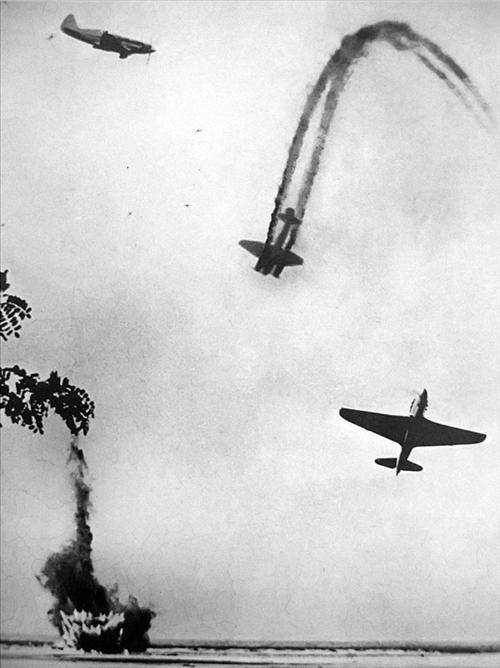
Air battle
Operation number 303 headquarters 281 ShAD, v. Vyachkovo to 23.00 27 July 1943 of the year.
872 ShAP during 9.04-20.20 27 July 1943 by five aircraft IL-2 undercover 4 fighters on every couple of free hunting method sought out and destroyed the movable rail and the enemy vehicles on the roads: Mga, Caps, Luban, Tosno, Luban, Beziers, Nurma and destroyed the firepower and manpower of the enemy in the area of the nameless height 1 km southwest of Porechye.
6-th aircraft produced 10 sorties. Flight 9 hours 10 minutes.
Ammunition expended: 12 FAB-100, 18 FAB-50, 6 AO-25, 34 PC-82, 1000 ShVAK, 700 SHKAS.
Destroyed and damaged: 4 guns of different caliber, 4 mortar. Scattered and partly destroyed before 30 soldiers and officers of the enemy.
Losses: they did not return from the 2 Il-2 combat mission, the pilots - Sergeant Maximov and Junior Lieutenant Lyapin, the air arrows - Sergeants Chuprov and Kuzmin. According to the reports of the covering fighters it is known: in the Borodulino area, the leading IL-2 aircraft, Sergeant Maksimov, was shot down by fire ZA, the latter deployed the aircraft and sent it to the enemy ammunition depot, blew it up. The crew - Sergeant Maximov and Sergeant Chuprov died.
The second IL-2 junior lieutenant Lyapin turned and went north. Results unknown. Accompanying fighters at this time were associated with the battle with. 6 th FV-190.
Now it becomes clear why the fighter pilots could not trace the fate of the second IL-2 aircraft, which had left the target in a northerly direction. They were fighting in the air! Moreover, as they say in an opsvodka to cover a pair of hunters (Maximov's and Lyapin's planes) four fighters flew out. An air battle took place with a numerically superior enemy - it is indicated that our fighters were fighting with the six PV-190. And now, let's think logically! Four of our fighters is fighting with the enemy's six. The height where the battle took place, most likely, was much higher than the height at which the attack aircraft worked, striking at the enemy. This is a truism. During the bombing attack, the Il-2 aircraft operated at altitudes from 25 to 1200 meters, depending on the mission and the bomb-assault weaponry. Cover fighters, in order not to fall under enemy anti-aircraft fire, rose higher and provided attack aircraft with a way out of the attack. In archival documents and memoirs literature there are confessions of fighter pilots who say that they often lost visual observation of the attack aircraft with a large difference in altitude, attack aircraft were lost against the background of the earth ...
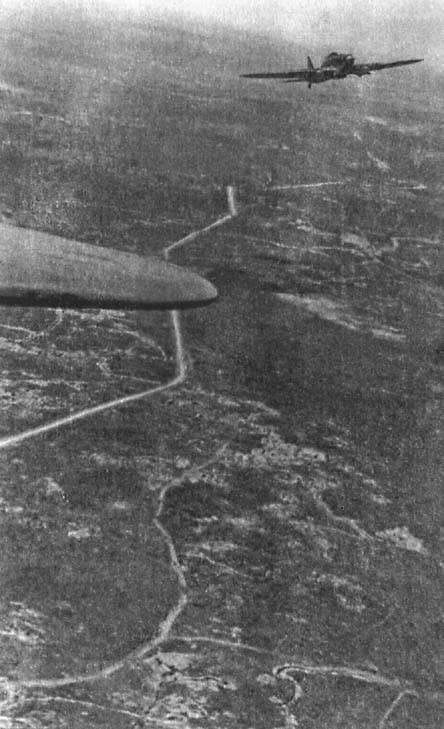
IL-2 at the exit of the attack
This suggests that it is very difficult for a fighter pilot to conduct visual observation of an escorted aircraft, and even more so in an opt-in report that fighters were engaged in aerial combat with a numerically superior enemy! On the basis of what the fighters concluded that it was Maximov’s plane that turned around and went to the ammunition depot? Did Lyapin's plane go north? And now the most important thing: the Il-2 aircraft we found with the remains of Guriy Maksimov and Kuzma Chuprov was just north of Borodulino towards Lake Ladoga! From the foregoing, we can assume that escort fighters, observing the death of one aircraft and losing visual contact with the second aircraft, concluded that Maximov's plane went to the warehouse, and Lyapin's plane went north! What has been confirmed this statement is not yet clear to us? Did fighters see aircraft side numbers? Did you hear the message of the dying crew on the radio? The operational report of the 269 th fighter aviation division, the fighters of which in July 1943 covered the attack aircraft of the 281 th attack aviation division, may help to understand this. But, the fact of finding the wreckage of Maximov’s aircraft in more than 20 kilometers north of Borodulino, suggests that the ammunition depot was rammed by crew of junior lieutenant Ivan Lyapin and sergeant Mikhail Kuzmin.
The circumstances of the death of two of our planes that are being clarified now do not nearly detract from the greatness of the accomplished feat of Guria Maksimov and Kuzma Chuprov. This bitter and tragic truth makes you think more about the cruelty and vicissitudes of war! The IL-2 aircraft of Guriy Nikolayevich Maximov with the air gunner Kuzma Alekseevich Chuprovym did not reach the road going from Maluksy to the Caps of all 300 meters. The fact is that along this road the Germans were equipped and had warehouses of rear services, dugouts for personnel, and caponiers for equipment.
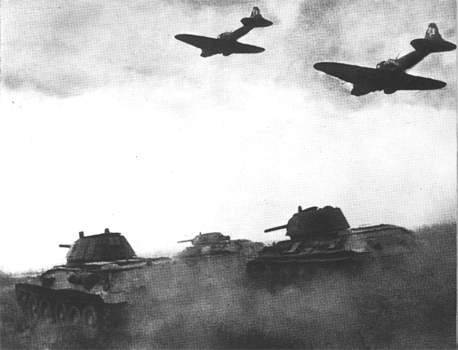
Attack of the T-34, IL-2 tanks.
Let us try again to briefly describe the 27 July 1943 sortie. Two Il-872 attack planes take off from the 2 th assault air regiment to the free hunt, as part of the Maksimov-Chuprov and Lyapin-Kuzmin crews. To escort and cover them, a troop of Yak-1 fighters from the 287 th Fighter Aviation Regiment under the command of Senior Lieutenant Borisov takes off. At 18 hours, attack aircraft find targets for the bomb attack at the Borodulino airfield and begin to attack. The height at which the IL-2 aircraft strike from 50 to 1200 meters. At the same time, the three Yak-1 b fighters, which were obliged to cover the attack aircraft at the exit from the attack, enter into air combat with a numerically superior enemy. As follows from the documents of the Fighter Aviation Regiment, our planes were attacked by the EF-190 and one Me-110. The characteristic mixed layout of the German air group suggests that, most likely, German fighters accompanied their reconnaissance aircraft, who were returning or taking off for a combat mission from the Borodulino airfield. The air battle between the fighters was much higher in height than the one at which the attack aircraft worked. The air battle was unsuccessful on both sides. But at that time, both of our Il-2 attack aircraft were hit by anti-aircraft fire. One of the escort fighters manages to notice that one of the shot down attack aircraft turns around and deliberately crashes into an ammunition depot located on the edge of an enemy airfield.
The second Il-2 attack aircraft, when hit by an under attack, moves north of the airfield towards Lake Ladoga. But since escort fighters are shackled by combat with German aircraft, they do not have time to trace (not to mention that they should have escorted) the second IL-2, which is not returned to its airfield. Thus, in the headquarters of the 872 th assault air regiment, both aircraft belong to the category of not returning from a combat mission. When they return our fighters to their own airdrome, they report what they have seen: one IL-2 crashed into a warehouse, the second went north. Most likely, they could not indicate exactly which on-board number the aircraft crashed into the ammunition depot, and which aircraft went down from the target, because the following factors greatly influenced this: height difference, confluence below the flying airplane against the terrain, ( do not forget that we are talking about summer) and air combat with superior enemy forces. Therefore, to indicate that it was the Maksimov-Chuprov aircraft that rammed the ammunition depot could only be at the headquarters of the 872 th assault air regiment, when drawing up the next operational report. Divisional and army operational reports simply duplicated the regiment’s report and conclusions. But the fact remains the fact! The wreckage of the aircraft and the remains of the Maximov-Chuprov crew were found in 24 km from the Borodulino airfield, and the place of detection was located north of the airfield. The fact that the fire ram in the summer of 1943, at the Borodulino airfield took place, was also confirmed!
It follows from the above that the fire ram 27 of June 1943 was performed by the crew of the IL-2 aircraft, consisting of:
- Pilot, Junior Lieutenant Lyapin Ivan Panteleevich (born 1918, born in Voronezh Region; Budenovsky District, Khutorsky Farm; Lyapina’s wife Nina Gavrilovna lived in the Kazakh SSR, the city of Uralsk, Pochitalinskaya Village, 54.
- air gunner, senior sergeant Kuzmina Mikhail Mikhailovich (1915 b., Born in Tatar Autonomous Soviet Socialist Republic Lapinsky district, Sredne-Devyatovo village, Byrikov’s wife (Byrinova) Alexandra Pavlovna lived in Tatar Autonomous Soviet Socialist Republic Tenkovsky district Grebenevsky glass factory. .
November 8 morning 2007 of the year in Novosibirsk was issued by winter standards, extremely warm, but rainy. As if nature itself mourned the delivered remains of its countryman to the Motherland. Droplets drizzle like tears froze on the black overcoats of cadets of the Siberian Cadet Corps. After a farewell mourning rally in the building of the House of Culture in the village of Verkh-Tula, on which many touching words were said about Kuzma Alekseev Chuprov, a huge procession of residents of the village lined up on the street, who came to say goodbye to their countryman. At the head of the column with a lowered red banner was a company of the guard of honor. Behind her, on the shoulders of young guys, they carried a coffin with the remains of a hero. According to Orthodox tradition, the rector of the local church held a memorial service, and the last words of the prayer for eternal memory were sunk into the souls of all the people around. The paper coffin gently descended into his native Novosibirsk land, right next to the little mound of his native mother.
Just a soldier returned home, returned to his mother in the land of the people. Not for nothing on the monument at Kuzma Alekseevich Chuprov the last line inscribed the words: "... Mom, I came back ...".
12 of May 2008 of the year, in the Prince-Vladimir church a funeral was held by Guriy Maximov. The touching words of the prayer: “Make him eternal memory.” Within the walls of the church, next to the ashes of the deceased pilot, there was his photo and tablet made by the hands of Novosibirsk search engines with his only lifetime award — the medal “For the Defense of Leningrad”.
To the sounds of the national anthem and farewell salute, the native land of Vladimir accepted the remains of her son, the pilot of the 872 th assault air regiment of junior lieutenant Guriy Nikolaevich Maximov. He was buried in the new city cemetery in Vysokovo, near the graves of his sisters and brother, who never received his return home. But the most touching words were written out on the erected monument: “Mom, I came back ...”.
This is how the souls of two young guys from 43, Junior Lieutenant Guriy Nikolayevich Maximov and Red Army soldier Kuzma Alekseevich Chuprov, who left their mark in the memory of people ... finally calmed down.
Yes, it was not they who did the fire ram on the Borodulin airfield, but didn’t they deserve the right to be awarded with military orders, for which they paid for their young lives? Both dead crews on the summer day of 27 July 1943, already because they deserve the title of a hero, because they were going to die a real mission! We have already told what a German airfield in Borodulino near Lubania represented. When departing for a combat mission, both crews were tasked with a “free hunt”. They could choose a target and less defended by anti-aircraft guns, could bomb and shoot any enemy convoy on the roads, drop bombs on small enemy garrisons and leave alive, return to their airfield! But! They, the crews of Maximov - Chuprova and Lyapina - Kuzmina, chose the hardest, most difficult target for the attack aircraft! They understood that they were going to die! That is the greatness of their EXPLOIT!
Information